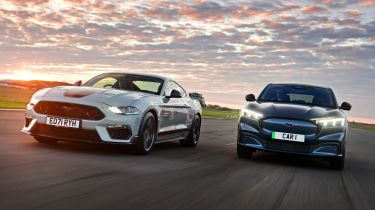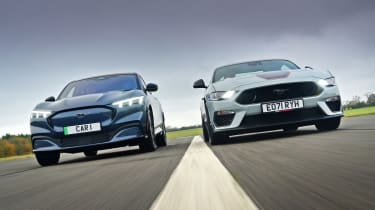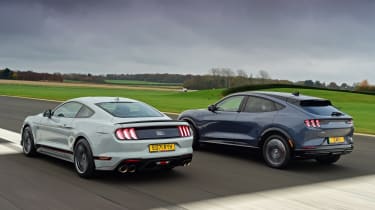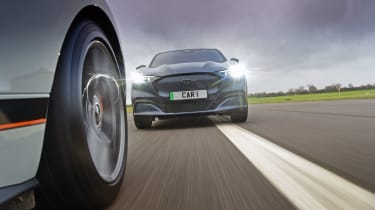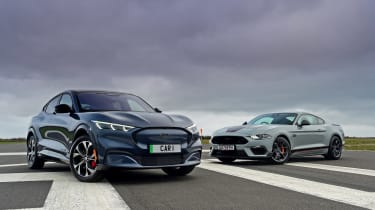Ford Mustang Mach 1 vs Ford Mustang Mach-E: petrol vs electric twin test
Ford has jumped into the world of electrification by bringing its iconic Mustang up to date. Here the Mach-E meets the Mach 1 to see if the pony car’s DNA still remains...
Come up with a list of motoring icons, and the Ford Mustang is sure to be in there. It’s a car, like the Beetle or Jeep, that’s identifiable by a single name, and it has provided performance for the masses since the first cars hit showrooms back in 1964.
The Mustang has had its ups and downs – from racing success in a variety of disciplines, to the ill-conceived Mustang II ‘economy’ model of the 1970s – but the current car, first launched in 2015, is a true global success story. Yet it now exists at a time when the car industry is in the biggest state of flux it’s seen in its 130-year history.
Electrification is upon us, but rather than consign the Mustang to combustion-powered history, Ford is reinventing it for this new era. Traditionalists have baulked at the electric Mustang Mach-E, and some would say they have just cause. How exactly can a five-door SUV live up to the Mustang’s hairy-chested reputation?
Lining the electric model up against the Mustang Mach 1 – the flagship of the Mustang sports car range in the UK – it’s clear that the Mach-E’s proportions are a world away from the traditional coupé. Both cars are the same width and a similar length, but the Mach-E’s longer wheelbase, five-door layout and taller, longer roof mean its profile is at odds with the sleek two-door.
Used - available now

2024 Volkswagen
Polo
26,127 milesAutomaticPetrol1.0L
Cash £17,375
2022 Peugeot
308 SW
45,289 milesAutomaticPetrol1.2L
Cash £16,025
2024 Peugeot
2008
14,766 milesAutomaticPetrol1.2L
Cash £17,025
2024 Toyota
Aygo X
26,564 milesAutomaticPetrol1.0L
Cash £13,350Its design isn’t entirely different, though. The shape of the side windows follows a similar line, for instance, and the clever ‘twin roof’ aesthetic creates a sportier look without sacrificing rear-seat headroom. In some ways the Mach-E even gives you an idea of what a shooting brake version of the coupé could look like. But it’s the details that really connect the Mach-E with the sports car. The stylised grille, sharp LED headlights and three-bar tail-lights all tap into the traditional Mustang look, while the galloping horse badge is used liberally, too.
These touches add some Mustang flavour to the Mach-E, but it’s the Mach 1 that has the greater visual appeal. It takes the standard sixth-generation Fastback coupé and adds go-faster touches inspired by the original Mach 1 of 1969. Twin bonnet vents, stripes and a rear diffuser taken from the US-market Shelby GT500 give it a more aggressive look, while our car’s optional alloy wheels are wrapped in Michelin Pilot Sport tyres that are designed to deliver a more focused drive. The Mach-E isn’t the only model that looks at Ford’s heritage for inspiration, either, because the Mach 1’s badges use the same lettering as seen on the 1969 original.
That first Mach 1 marked the arrival of a more powerful V8 and chassis tweaks for the Mustang, which were deemed necessary so it could keep pace with its rivals in the US muscle car wars of the late sixties and early seventies. The current Mach 1 also adds power, although its 454bhp is a modest 10bhp up on the standard GT and is the same as was found in the limited-edition Mustang Bullitt. There are some other pieces of fine tuning to enhance the driving experience, though.
The six-piston Brembo brakes are upgraded, while a new aero package improves airflow over the car. At the rear a heat exchanger helps to keep the limited-slip diff cool for improved performance. Inside, the upgrades include a ‘pool ball’ shift knob to go with the upgraded short-throw six-speed gearbox and twin-plate clutch, while Mach 1 branding and special upholstery and stitching are added.
These additions go some way to justifying the Mach 1’s £56,995 list price, but the focal point for most potential buyers will be that V8 under the bonnet. In terms of aural excitement, it doesn’t disappoint. A revised exhaust means it delivers a throaty rumble (although you can reduce this using the quieter ‘good neighbour’ mode) and the 5.0-litre unit sounds fantastic through the entire rev range.
It has the performance to back it up, too. There’s a 0-62mph time of 4.8 seconds, and since peak power arrives at a heady 7,250rpm, you have to wring every last rev out of the motor to achieve maximum performance. The six-speed box has short throws, but it needs a positive, somewhat forceful touch to get it working properly, while the heavy clutch gives your left leg a workout, too. That’s something which will soon become a rarity in the era of electrification.
The Mach 1 isn’t entirely at home on twisting British B-roads, because it’s still a relatively large car and its stiff set-up means it tends to hunt cambers. But the damping is well measured, offering a good balance between comfort and roadholding. Fast steering reacts quickly to inputs and helps you get a feel of what the front tyres are doing, too, most certainly helped by the fact that they’re not having to put power to the road at the same time. A broad power band means that, while using the V8’s full potential can see the rear tyres break traction even in higher gears when the road is slippery, it’s also relatively docile when you take it easy, and it simply burbles along when cruising.
However, the Mach-E is in another league for refinement. Near-silent electric drive means there’s hardly any noise in the cabin, whether you’re driving around town or cruising at motorway speeds. With 346bhp from its twin electric motors (one for each axle), the Mach-E is 108bhp down on the Mach 1, but since maximum power and 580Nm of torque (51Nm more than the Mach 1) are both available from the instant you hit the throttle, a 0-62mph time of 5.1 seconds is surprisingly competitive. The Mach-E delivers the sprint with the minimum of fuss, too, just as you would expect from any powerful EV. Of course, four-wheel-drive traction helps the Mach-E off the line, but it’s also carrying an extra 343kg over the Mach 1, so its sprint time is that much more impressive.
Weight is a major hurdle for all electric cars to overcome in terms of handling. To compensate for its 2.2-tonne kerbweight, Ford has given the Mach-E a stiff suspension set-up, and in the process has created common ground between it and the Mach 1, since they’re both relatively firm and behave in a similar manner. The Mach-E also hunts cambers on undulating B-roads, but while the Mach 1 is tuned to offer positive feedback and an engaging drive, the Mach-E is just trying to keep its weight in check.
The reality is that while the Mach-E is a pretty decent electric car to drive, it doesn’t have the fun factor to match the Mach 1. There’s lots of grip and a similar quick steering set-up, but overall the Mach-E isn’t a car that you’d ever feel the need to hustle, and it certainly doesn’t offer the kind of satisfaction, aural or otherwise, that is available in the V8 machine.
It’s better to revel in the car’s comfort instead, and there’s plenty of it. While the Mach 1 has a low-slung driving position that puts you behind a dashboard and a vast bonnet, the Mach-E is more upright. It’s certainly not as sporty – it’s almost like an MPV in comparison – and the dashboard sits relatively low in front of you.
The fascia is dominated by that vast 15.5-inch portrait touchscreen, and it demonstrates where the two Mustangs diverge considerably. Five years is a long time in terms of technology, and while the Mach 1’s infotainment was once a cutting-edge set-up, it’s positively archaic when compared with the Mach-E’s system. Ford has constantly evolved its operating system, and the Next Generation Sync set-up in the Mach-E offers far greater connectivity than the coupé’s older Sync 3 software.
The dials are in stark contrast, too. While the Mach 1 has a digital set-up that can be configured to display information in different ways, the pod they’re in looks traditional. In the Mach-E, the display immediately in front of the driver is more like one of those digital advertising boards that you get at the airport or train stations, with lots of colourful animations and bold colours to draw your attention.
Perhaps this sheds light on what we can expect in an electrified future. With electric motors narrowing choice in terms of drivetrain configuration, and the almost uniform format of having a heavy battery pack mounted low between the axles, manufacturers are going to have to find different ways to wow customers. Ford has been canny by tapping into its Mustang heritage to ease into the transition to electric drive – it brings familiarity to a technology that can almost seem alien to some buyers. So while a few diehard fans will call it sacrilege, there are probably more people out there that are happy to say that they drive a Mustang, even if it is an electric SUV.
They’ll certainly be paying for the privilege. Prices ranging from £42,500 to slightly more than £66,000 mean the Mach-E covers a wider spread than the £46,000-£59,000 for the sports car. Delve a little deeper, and the Mach 1’s residual values are ahead of the EV’s, showing that perhaps buyers are switching on to the fact that sports cars such as this won’t be around for much longer.
Super-low ‘fuel’ costs for the Mach-E will go a long way to justifying its initial outlay, while a range of 335 miles for the Extended Range AWD model here means it’ll go further than the Mach 1 if you manage to achieve its official 22.8mpg. Of course, use the Mach 1’s potential to the full, and you’ll end up with a driving range that even the most compromised EV could beat –but who would be having the most fun in the process?
What do owners think?

Since the Mach 1 and Mach-E are so different, few buyers will be choosing between them. But for some lucky punters, owning both makes for a sweet two-car garage.
Brian and Pat Vayro (above) did that when they took delivery of a Mach-E to complement their Mach 1 earlier this year. “The Mach 1 is the third modern Mustang I’ve owned,” Brian said. “And when I saw the Mach-E was coming, I thought that I’ll have one of those too. Pat loves it because she can get her golf clubs in the boot without having to put the seats down.”
Somebody else who has taken the plunge is David Spooner (with his wife Jayne). Speaking about the Mach-E, David said: “I was looking for a vehicle that would accommodate us better as a family. The technology first drew my attention to the Mach-E and, coupled with the increased space that the car offers, it was a logical choice for us in the end.”
But David’s Mustang connection doesn’t end there, because his company, Safeguard SVP, is developing the Mach-E as a blue-light emergency vehicle. “We have a lot of work to do to develop this car into a working vehicle, especially in terms of the electrics, with all the lights and other equipment it will have to power,” he said. “It’s an exciting project to work on.”
Verdict
The times are changing, but the Mustang is going with the flow so that it remains relevant for future generations. At the moment, the connection the Mach-E has with previous generations is more aesthetic than mechanical, but its decent range and tech-packed, family-friendly SUV shape will help to keep EV enthusiasts and newcomers to electrification engaged.
As for the Mach 1, it’s a high watermark for Ford’s original pony car, and will go down in history as one of the best Mustangs ever. As a last hurrah for V8-powered sports cars, it ticks all the right boxes – there’s a broad spread of performance, and of course the sound of a naturally aspirated V8 is always music to the ears of an enthusiast. It’ll be a sad day – unfortunately one that’s coming soon – when cars such as this are no longer offered in dealerships.
So what’s next for Ford? Well, if it really wants to make a mark in the world of EVs, then maybe a Mustang-E coupé is the next step? Lighter, more compact battery tech will probably be needed first, but if Ford could bridge the gap between the past and future with an electric sports car, it could be a winner.

